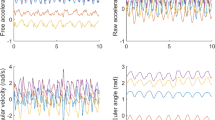Abstract
Wearable accelerometers provide an objective measure of human physical activity. They record high-frequency unlabeled three-dimensional time series data. We extract meaningful features from the raw accelerometry data and based on them develop and evaluate a classification method for the detection of walking and its subclasses, i.e., level walking, descending stairs, and ascending stairs. Our methodology is tested on a sample of 32 middle-aged subjects for whom we extracted features based on the Fourier and wavelet transforms. We build subject-specific and group-level classification models utilizing a tree-based methodology. We evaluate the effects of sensor location and tuning parameters on the classification accuracy of the tree models. In the group-level classification setting, we propose a robust feature inter-subject normalization and evaluate its performance compared to unnormalized data. The overall classification accuracy for the three activities at the subject-specific level was on average 87.6%, with the ankle-worn accelerometers showing the best performance with an average accuracy 90.5%. At the group-level, the average overall classification accuracy for the three activities using the normalized features was 80.2% compared to 72.3% for the unnormalized features. In summary, a framework is provided for better use and feature extraction from raw accelerometry data to differentiate among different walking modalities as well as considerations for study design.








Similar content being viewed by others
References
Bai J, Goldsmith J, Caffo B, Glass TA, Crainiceanu CM (2012) Movelets: a dictionary of movement. Electron J Stat 6:559
Banos O, Galvez JM, Damas M, Pomares H, Rojas I (2014) Window size impact in human activity recognition. Sensors 14(4):6474–6499
Bao L, Intille SS (2004) Activity recognition from user-annotated acceleration data. In: International Conference on Pervasive Computing, Springer, pp 1–17
Campbell KL, Crocker P, McKenzie DC (2002) Field evaluation of energy expenditure in women using tritrac accelerometers. Med Sci Sports Exerc 34(10):1667–1674
Ellis K, Kerr J, Godbole S, Staudenmayer J, Lanckriet G (2016) Hip and wrist accelerometer algorithms for free-living behavior classification. Med Sci Sports Exerc 48(5):933–940
Esliger DW, Rowlands AV, Hurst TL, Catt M, Murray P, Eston RG (2011) Validation of the genea accelerometer. Med Sci Sports Exerc 43(6):1085–1093
Harris FJ (1978) On the use of windows for harmonic analysis with the discrete fourier transform. Proc IEEE 66(1):51–83
He B, Bai J, Zipunnikov VV, Koster A, Caserotti P, Lange-Maia B, Glynn NW, Harris TB, Crainiceanu CM (2014) Predicting human movement with multiple accelerometers using movelets. Med Sci Sports Exerc 46(9):1859–1866
Kwapisz JR, Weiss GM, Moore SA (2011) Activity recognition using cell phone accelerometers. ACM SigKDD Explor Newsl 12(2):74–82
Mannini A, Intille SS, Rosenberger M, Sabatini AM, Haskell W (2013) Activity recognition using a single accelerometer placed at the wrist or ankle. Med Sci Sports Exerc 45(11):2193
Ohtaki Y, Susumago M, Suzuki A, Sagawa K, Nagatomi R, Inooka H (2005) Automatic classification of ambulatory movements and evaluation of energy consumptions utilizing accelerometers and a barometer. Microsyst Technol 11(8–10):1034–1040
Pober DM, Staudenmayer J, Raphael C, Freedson PS et al (2006) Development of novel techniques to classify physical activity mode using accelerometers. Med Sci Sports Exerc 38(9):1626
Preece SJ, Goulermas JY, Kenney LP, Howard D (2009) A comparison of feature extraction methods for the classification of dynamic activities from accelerometer data. IEEE Trans Biomed Eng 56(3):871–879
RStudio Team (2015) RStudio: integrated development environment for R. RStudio, Inc., Boston, MA. http://www.rstudio.com/
Sejdić E, Djurović I, Jiang J (2009) Time-frequency feature representation using energy concentration: an overview of recent advances. Digit Signal Proces 19(1):153–183
Straczkiewicz M, Urbanek J, Fadel W, Crainiceanu C, Harezlak J (2016) Automatic car driving detection using raw accelerometry data. Physiol Meas 37(10):1757
Therneau T, Atkinson B (2015) An introduction to recursive partitioning using the rpart routines. Mayo Foundation, Rochester, MN
Therneau T, Atkinson B, Ripley B (2015) rpart: recursive partitioning and regression trees. http://CRAN.R-project.org/package=rpart, r package version 4.1-10
Troiano RP, Berrigan D, Dodd KW, Masse LC, Tilert T, McDowell M et al (2008) Physical activity in the united states measured by accelerometer. Med Sci Sports Exerc 40(1):181
Urbanek JK, Zipunnikov V, Harris T, Fadel W, Glynn N, Koster A, Caserotti P, Crainiceanu C, Harezlak J (2018) Prediction of sustained harmonic walking in the free-living environment using raw accelerometry data. Physiol Meas 39(2):02NT02
Veltink PH, Bussmann HJ, De Vries W, Martens WJ, Van Lummel RC (1996) Detection of static and dynamic activities using uniaxial accelerometers. IEEE Trans Rehabil Eng 4(4):375–385
Xiao L, He B, Koster A, Caserotti P, Lange-Maia B, Glynn NW, Harris TB, Crainiceanu CM (2016) Movement prediction using accelerometers in a human population. Biometrics 72(2):513–524
Zhang S, Rowlands AV, Murray P, Hurst TL, et al (2012) Physical activity classification using the genea wrist-worn accelerometer. PhD thesis, Lippincott Williams and Wilkins
Acknowledgements
This paper was made possible, in part, with support from the Indiana Clinical and Translational Sciences Institute Design and Biostatistics Pilot Grant funded, in part by Grant UL1TR001108, from the National Institutes of Health, National Center for Advancing Translational Sciences, Clinical and Translational Sciences Award. Jaroslaw Harezlak has received funding from the National Institute of Mental Health research Grant R01MH108467.
Author information
Authors and Affiliations
Corresponding author
Supplemental Results Tables
Supplemental Results Tables
See Appendix Tables 3, 4, 5, 6.
Rights and permissions
About this article
Cite this article
Fadel, W.F., Urbanek, J.K., Albertson, S.R. et al. Differentiating Between Walking and Stair Climbing Using Raw Accelerometry Data. Stat Biosci 11, 334–354 (2019). https://doi.org/10.1007/s12561-019-09241-7
Received:
Revised:
Accepted:
Published:
Issue Date:
DOI: https://doi.org/10.1007/s12561-019-09241-7




